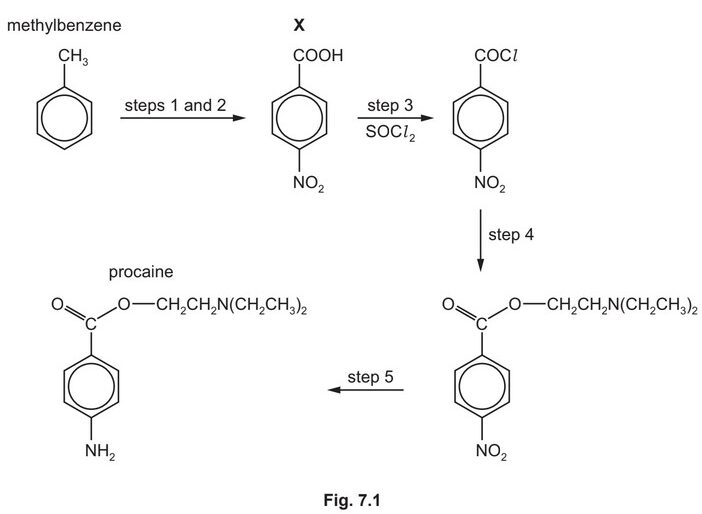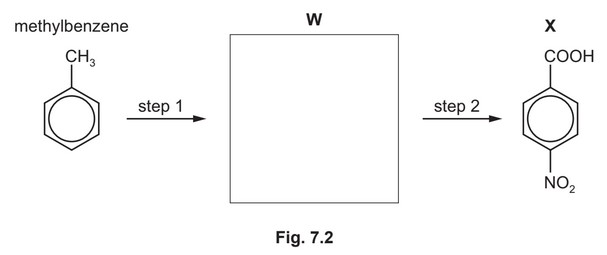Question
Nitrobenzene, $\mathrm{C}_6 \mathrm{H}_5 \mathrm{NO}_2$, can be reduced to phenylamine, $\mathrm{C}_6 \mathrm{H}_5 \mathrm{NH}_2$, in acid solution in a two step process.
(a) (i) Balance the half-equation for this reaction to work out how many moles of electrons are needed to reduce one mole of nitrobenzene.
$\mathrm{C}_6 \mathrm{H}_5 \mathrm{NO}_2+\ldots \ldots \ldots \mathrm{e}^{-}+\ldots \ldots \ldots . . \mathrm{H}^{+} \rightarrow \mathrm{C}_6 \mathrm{H}_5 \mathrm{NH}_2+\ldots \ldots \ldots \ldots \mathrm{H}_2 \mathrm{O}$
(ii) The reducing agent normally used is granulated tin and concentrated hydrochloric acid. In the first step, the reduction of nitrobenzene to phenylammonium chloride can be represented by the equation shown.
Use oxidation numbers or electrons transferred to balance this equation. You might find your answer to (i) useful.
$
. \mathrm{C}_6 \mathrm{H}_5 \mathrm{NO}_2+\ldots . . \mathrm{HCl}+\ldots \ldots . \mathrm{Sn} \rightarrow \ldots \ldots \mathrm{C}_6 \mathrm{H}_5 \mathrm{NH}_3 \mathrm{Cl}+\ldots \ldots . \mathrm{SnCl}_4+\ldots \ldots . \mathrm{H}_2 \mathrm{O}
$
(b) When $5.0 \mathrm{~g}$ of nitrobenzene was reduced in this reaction, $4.2 \mathrm{~g}$ of phenylammonium chloride, $\mathrm{C}_6 \mathrm{H}_5 \mathrm{NH}_3 \mathrm{Cl}$, was produced.
Calculate the percentage yield.
percentage yield of phenylammonium chloride = ……………………….. % [2]
(c) Following the reaction in (b), an excess of $\mathrm{NaOH}(\mathrm{aq})$ was added to liberate phenylamine from phenylammonium chloride.
(i) Calculate the mass of phenylamine, $\mathrm{C}_6 \mathrm{H}_5 \mathrm{NH}_2$, produced when $4.20 \mathrm{~g}$ of phenylammonium chloride reacts with an excess of $\mathrm{NaOH}(\mathrm{aq})$.
mass of phenylamine = ……………………….. g [1]
The final volume of the alkaline solution of phenylamine in (i) was $25.0 \mathrm{~cm}^3$. The phenylamine was extracted by addition of $50 \mathrm{~cm}^3$ of dichloromethane. After the extraction, the dichloromethane layer contained $2.68 \mathrm{~g}$ of phenylamine.
(ii) Use the data to calculate the partition coefficient, $K_{\text {partition }}$, of phenylamine between dichloromethane and water.
$
K_{\text {partition }}=
$
d) How does the basicity of phenylamine compare to that of ethylamine? Explain your answer.
(e) Phenol can be synthesised from phenylamine in two steps

i) State the reagents and conditions for steps 1 and 2.
step 1 ………………………………………………………………………………………………………………….
step 2 …………………………………………………………………………………………………………………. [2]
(ii) Draw the structure of the intermediate compound E in the box above. [1] [Total: 13]
▶️Answer/Explanation
Ans:
(a) (i) $\mathrm{C}_6 \mathrm{H}_5 \mathrm{NO}_2+6 \mathrm{e}^{-}+6 \mathrm{H}^{+} \longrightarrow \mathrm{C}_6 \mathrm{H}_5 \mathrm{NH}_2+2 \mathrm{H}_2 \mathrm{O}$
(b) $\quad\left(\mathrm{M}_{\mathrm{r}}\right.$ values: $\left.\mathrm{C}_6 \mathrm{H}_5 \mathrm{NO}_2=123 \mathrm{C}_6 \mathrm{H}_5 \mathrm{NH}_3 \mathrm{Cl}=129.5\right)$ theoretical yield $=5.0 \times 129.5 / 123=5.26 \mathrm{~g}$ percentage yield $=100 \times 4.2 / 5.26=79.8 \%(80 \%)$
(c) (i) $\mathrm{C}_6 \mathrm{H}_5 \mathrm{NH}_2=93$
yield of phenylamine $=4.2 \times 93 / 129.5=3.016 \mathrm{~g}$
(ii) mass left in water $=3.016-2.68=0.336 \mathrm{~g}$ $K_{\text {part }}=(2.68 / 50) /(0.336 / 25)=3.99$
(d) phenylamine is less basic that ethylamine the lone pair on $\mathrm{N}$ is delocalised over the ring…
…making it less available for reaction with a proton $/ \delta+\mathrm{H}$
(e) (i) step 1: $\mathrm{HNO}_2 \mathrm{OR}\left(\mathrm{NaNO}_2+\mathrm{HCl}\right)$ at $T \leqslant 10^{\circ} \mathrm{C}$ step 2: boil/heat in water
(ii)

Question
Procaine is used as an anaesthetic in medicine. It can be synthesised from methylbenzene in five steps as shown in Fig. 7.1.
(a) (i) Name all the functional groups present in procaine.
(ii) A molecule of procaine has 13 carbon atoms.
State the number of carbon atoms that are sp, \(sp^2\) and \(sp^3\) hybridised in procaine.
sp carbons = ………………… \(sp^2\) carbons = ………………… \(sp^3\) carbons = …………………
(b) The proton (\(^1H\)) NMR spectrum of procaine dissolved in \(D_2O\) is recorded.
Predict the number of peaks observed.
(c) State why procaine can act as a base.
(d) Compound X can be synthesised in two steps from methylbenzene.
(i) Draw the structure of compound W in the box provided. [1]
(ii) State the reagents and conditions for step 1 and step 2.
step 1 ………………………………………………………………………………………………………………….
step 2 ………………………………………………………………………………………………………………….
(e) Procaine is synthesised in three steps from X.
Suggest the reagents and conditions for step 4 and for step 5 in Fig. 7.1.
step 4 ………………………………………………………………………………………………………………………..
step 5 ………………………………………………………………………………………………………………………..
(f) (i) Explain what is meant by partition coefficient, \(K_{pc}\).
(ii) The partition coefficient of procaine between octan-1-ol and water is 1.77.
Octan-1-ol and water are immiscible. A solution containing 0.500g of procaine in 75.0cm3 of water is shaken with 50.0\(cm^3\) of octan-1-ol.
Calculate the mass of procaine that is extracted into the octan-1-ol.
mass of procaine extracted = ………………………… g
Answer/Explanation
Answer:
(a) (i) phenylamine AND amine AND ester
(ii) sp carbons = 0, \(sp^2\) carbons = 7, \(sp^3\) carbons = 6
(b) 6
(c) lone pair on the N can accept a proton
(d) (i) 
(ii) step 1 M1 concentrated \(HNO_3\) and \(H_2SO_4\)
step 2 M2 hot (alkaline) KMnO4 (followed by addition of \(H^+\))
(e) step 4 M1 \(HOCH_2CH_2N(CH_2CH_3)_2\)
step 5 \(M_2\) Sn AND HCl
M3 concentrated (HCl) AND heat / reflux
(f) (i) M1 ratio of the concentration of a solute in two solvents
M2 at equilibrium
(ii) M1 \(K_{pc} = [procaine]_{oct} / [procaine]_{water}\)
1.77 = (x / 50)/(0.5 – x / 75)
M2 1.77 = 1.5x / 0.5 – x
0.885 –1.77x = 1.5x
x = 0.271 g min 2sf